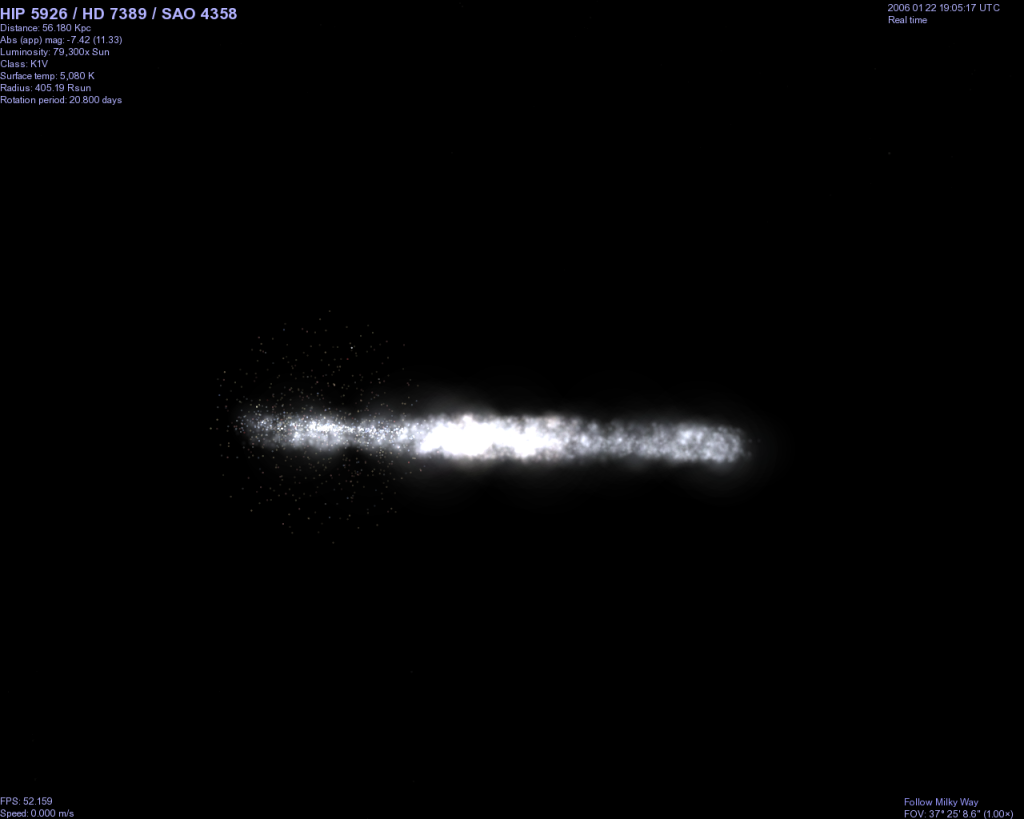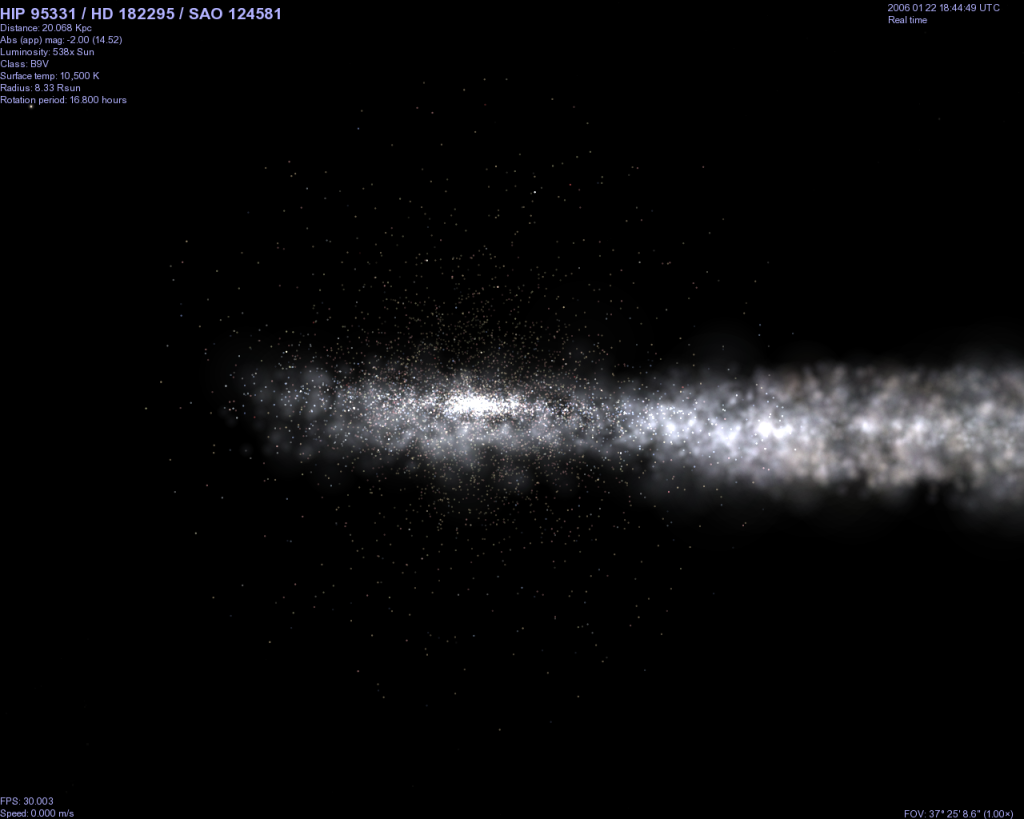Page 1 of 1
Odd star locations?
Posted: 26.01.2006, 04:57
by Johaen
I've been using this program for a couple weeks now, and while playing with the star magnitudes, I noticed something that seemed odd to me. When you have the magnitude all the way up, and you zoom out, you notice many stars well above and below the main plain of the Milky Way, as shown in the following two pictures:


Now, something to me is not right here. Either the stars are in the wrong position, the Milky Way galaxy is the wrong size, or this is actually how it is in real life, and I just don't know it.
Posted: 26.01.2006, 05:29
by GlobeMaker
The stars are accurate. The galaxy is a rough model that will improved in
the next few months and years. Scientists know more about local stars
than they do about distant stars.
Posted: 26.01.2006, 10:31
by selden
If you toggle off Galaxy rendering, Celestia will draw just the stars that had their distances measured by the Hipparcos satellite.
Bear in mind that the distances to the more distant stars are much less accurate than the distances to the nearer stars because their parallax values are tiny, close to the errors in their measurements.
Interesting
Posted: 28.01.2006, 00:28
by BrainDead
Well now... That's interesting.
Pardon the Brain-Dead question, but is it possible for stars to exist
outside of galaxies?
I know this is probably a stupid question, but I had always thought
that all stars were - born in, resided in, and died in - galaxies.
This is not true? Can stars be born outside of galaxies? If so, how?
I mean, where does the stuff of creation come from?
Again, sorry for the questions, but I really am curious to know these
things.
Thanks, Bob
Posted: 28.01.2006, 01:25
by GlobeMaker
" Is it possible for stars to exist outside of galaxies? "
Here is my guess :
Yes. Stars can be cast out of galaxies. A small star could be accelerated
by close encounters with several large stars. The small star could have enough
speed to get some distance away from the galaxy. I never calculated how
many stars have a known probability to do that, but if we count our lucky stars,
it may be less than zero. Analogies can be made with gas atoms
leaving a planet's atmosphere, or the slingshot effect
gravity boost that satellites get from
big planets. A lucky star could follow a bigger star to boost its speed. Then it could
follow another star for more boost. If enough of these chance encounters
go the right way, a star could be flung into the intergalactic void.
"Can stars be born outside of galaxies? If so, how? "
You need a professional astronomer to answer these question. I expect
that one will be along momentarily ...
Posted: 28.01.2006, 01:27
by Malenfant
well for starters, that's a galaxy rendering bug isn't it? It shouldn't be so bright if the magnitude limit is set to 15.00 - it shouldn't even be brightening at all should it?
Second, the errors on a lot of those stars are very large. For example, HIP 70781 has a parallax of 0.00026as, with an error of 0.00337as! That means its real parallax could be as high as 0.00363 (275 pc from Sol, or it could be er, really far away (as it is, its current parallax indicates that it's 3846pc from Sol - it could be even further).
Personally I think that if the error in parallax is greater than the actual parallax then the star should not be rendered. This would get rid of a lot of the more distant stars (which to be honest are quite discardable anyway) but would keep the more accurately known ones.
That said, this picture really doesn't look right. Do we really know the locations of all those extragalactic/halo stars? Is the galaxy being rendered at the right size?
And Bob - most stars are formed in galaxies or globular clusters (that orbit the galaxies). Sometimes they can get tossed out of the galaxies by gravitational interactions though, which explains how they can be seen beyond the main structure.
Posted: 28.01.2006, 01:33
by Malenfant
GlobeMaker wrote:Yes. Stars can be cast out of galaxies. A small star could be accelerated by close encounters with several large stars. The small star could have enough speed to get some distance away from the galaxy. I never calculated how many stars have a known probability to do that, but if we count our lucky stars, it may be less than zero. Analogies can be made with gas atoms leaving a planet's atmosphere, or the slingshot effect
gravity boost that satellites get from big planets. A lucky star could follow a bigger star to boost its speed. Then it could follow another star for more boost. If enough of these chance encounters go the right way, a star could be flung into the intergalactic void."
You're right that stars can get thrown out by gravitational interactions, but it doesn't work by some kind of "tag-team effect" like you describe

.
Usually stars get ejected from systems where there's three or more stars involved - IIRC if a wandering star encounters a pair of stars and interacts with them then usually it's the least massive star that is tossed out of the system. If it's tossed out in a direction that is beyond the galactic plane then it can end up in intergalactic space. It's somewhat unlikely that a star would exceed the escape velocity of the galaxy though, so what happens is that the star is usually put on an inclined orbit around the centre instead of its old one that was more aligned with the disk - so sometimes it'll be far above or below the disk and other times it'll be within the disk depending on where it is in its orbit.
Posted: 28.01.2006, 01:37
by buggs_moran
(EDIT: oof I was pre-posted)
Hey there,
Yes there are stars outside galaxies. They get thrown out of galaxies during gravitational interactions... However, I do believe they all form within galaxies. I would think the vast quantities of hydrogen necessary for even one newborn star would only be found in a galactic neighborhood.
By the way, there are lots of great astronomy questions here and we have tons of knowledgable people. I will often pose as one since I teach high school Astronomy, but my knowledge is limited to just beyond that. I think this site
http://curious.astro.cornell.edu/ is a wonderful source for many answers. I send my students to it often.
Posted: 28.01.2006, 01:46
by GlobeMaker
Thanks
Posted: 28.01.2006, 13:44
by BrainDead
Thanks all for the information.
This is fascinating. It makes sense that some stars could be "thrown away"
by gravitational influences, but it's really interesting to see that this could
happen to a relative "Many" stars.
So intergalactic space does contain stars. Wow.
Thanks Buggs, GlobeMaker for the links. Neat stuff.



